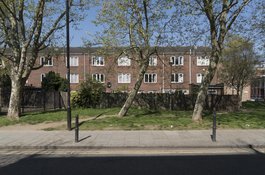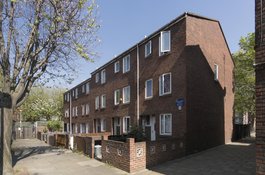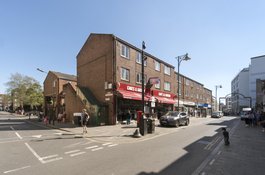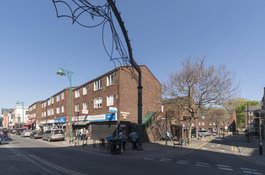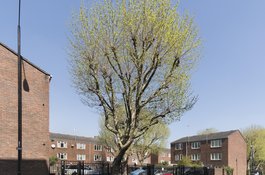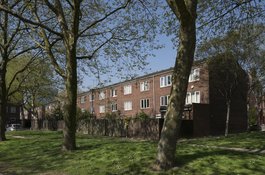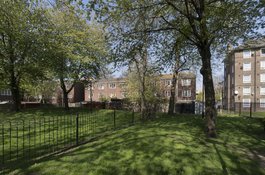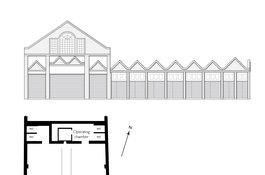Chicksand Street to Old Montague Street - early history
Contributed by Survey of London on March 30, 2017
The rectangle of Whitechapel parish that projects north of Old Montague Street
as far as Chicksand Street was part of the Halifax or Osborn estate along with
much of Mile End New Town to the north and east. In 1643 Edward Montague of
Boughton, Northants, and William Montague and Maurice Tresham, both of the
Middle Temple, bought this land from William Smith and others at the Middle
Temple. The holding passed to George Montague, who became second Baron Halifax
and first Earl of Halifax of the third creation, which title lapsed on the
death of his son George in 1771. His heir was a nephew, Sir George Osborn,
baronet, son of Sir Danvers Osborn of Chicksands Priory, Bedford. Much of the
Osborn property was sold in 1849 to redeem mortgages, much of the rest in the
twentieth century.
Most of the estate that lay in Whitechapel (twelve acres) was leased around
1643 by Leonard Gurle (_c._1621–1685) to make one of London’s earliest general
nursery gardens. Supplying fruit trees as well as ornamental plants, Gurle’s
‘great garden’ was London’s largest nursery in the 1660s and 70s, and
continued after Gurle became Charles II’s gardener at St James’s Palace in
1677. It included 299 asparagus beds, 11,600 plum, cherry and pear stocks and
127 mulberry trees. In 1719 it was still in the occupancy of a Martin Girle, a
son or grandson, though the twelve acres had been leased in 1717 to John Ward
and William Mason. By the 1670s Whitechapel's stretch of Brick Lane was
solidly built up with thirty-four houses, the largest with ten hearths
belonging to Leonard Gurle. Montague (later Manby) Court off the north side of
the west end of Mountague Street, close to where Frostic Place succeeded. The
Montague Street frontage had been largely built up by 1700. Mason’s Court
(later Osborn Place) was a good-quality development of _around _1720 at what
is now the west end of Chicksand Street. In Mason’s ‘Great Garden’ open ground
behind, John Wesley preached and was stoned by unreceptive locals in 1742. The
place was considered as a possible site for the London Hospital in 1749, but
rejected on account of the proximity of a white-lead house.
The Osborn property in Whitechapel that had remained open was humbly developed
in the first two decades of the nineteenth century. Chicksand Street was cut
through and an irregular array of humble ‘places’ (courts) popped up off its
south side and to the north of Finch Street (named after Heneage Finch, the
second wife of Sir George Osborn, and now Monthorpe Road), which stopped short
of Brick Lane where another tiny court, New Mason’s Court (later Hanover
Place), was built in the 1780s. What is now Spelman Street was laid out as
John Street, Casson Street as George Street (both renamed in 1883). Hope
Street linked Finch Street to what had by this time been dubbed Old Montague
Street.
The sites of 2–38 Brick Lane were occupied by 1680 by small houses, most
likely comparable to and contemporary with what was built to the west on the
Fossan Estate in Spitalfields in the late 1650s. Running east from the top
end, Mason’s Court, after William Mason, was a superior development of around
1720, eleven good-sized three-storey houses, many of them double fronted and
five bays wide. They became Osborn Place in the 1780s when (New) Mason’s Court
was formed to the south, about where Hopetown Street is now. Osborn Place was
again renamed as the west end of Chicksand Street in 1939. In its early days
as Mason’s Court a number of the occupants had French surnames, presumably of
Huguenot origin, and the silk industry was an important presence, spilling
over as growth out from Spitalfields. Along the north side, a weaver, Abraham
Fleury, had No. 2 by 1740, and Samuel Bradford and John Ireland, silk
dressers, were at No. 3 around 1790–1800. Among silk throwsters were James
Plantier then Peter Merzeau, who had No. 5, with a workshop, in succession
through the second half of the eighteenth century. At No. 2 in the 1820s was
William Ayres, a carpenter, his wife being a tambour maker. Poverty crept in.
At No. 3 Ellen Smiles, age 52 and recently widowed, living in a single room
with three children, her eldest Sarah, 18, working as a match-box maker, died
in 1864 of what was said, possibly inaccurately but nevertheless tellingly, to
be starvation. Two years later cholera deaths in the area were attributed to
overcrowding, particularly among Jewish immigrants, and in 1872 a house
further east in Chicksand Street was declared wholly unfit for habitation
after the death of a cellar-dweller.
Two of the Mason’s Court houses (originally Nos 6 and 7 at the east end of the
south side) survived into the 1960s as 8–12 Chicksand Street. These were for
many years the front premises of Robert Womersley & Son, drysalters
(dealers in chemical products). In 1797 Robert Womersley, a Yorkshire Quaker
and linen draper who had set up a dye house, took an Osborn lease of the
property to set up as a drysalter for dying and other purposes in what was
still then a textile district. From 1815 the family no longer lived at the
chemical factory, which had extended southwards to Finch Street by the 1850s.
In later years the works came to be wedged between a school and a hostel.
There were new warehouses in 1929 and 1938, but the firm moved away in the
1950s.
Chicksand Street and Finch Street were formed and humbly and irregularly built
up with small two-storey dwellings in the first years of the nineteenth
century. By 1812 they were linked (east to west) by George (Casson) Street,
Little Halifax (Tailworth) Street, John (Spelman) Street and three small
courts – Dowson’s Place, Luntley Place and Eele (later Ely) Place; Stephen
Eele was a mason based on the New Road who had a lease of two houses on the
south side of Osborn Place and who may thus have been responsible for Osborn
Court’s four small houses, Dowson and Luntley were other developers. In the
same period Hope Street was formed to connect Finch Street to Old Montague
Street. There was sugar refining on Finch Street by 1814, George Brienlech
setting up as a preparer of molasses and a cowkeeper. By the 1820s, there was
a diamond cutter on Luntley Place. Much of the land was alienated from the
Osborn Estate.
The principal later interventions were schools, first where Dowson’s Place and
Luntley Place had been, then replacing part of Osborn Place and Osborn Court.
Other nineteenth-century buildings, mostly two-storey dwellings, stood into
the 1970s. The Bell public house at 40 Brick Lane, returning on the north side
of Chicksand Street, had moved here from its more southerly site around 1785
to make way for the road improvement that created Osborn Street. It was
rebuilt in its present form in 1873 for Barclay Perkins & Co. The pub
closed and from 1969 to 2013 the premises were Sweet & Spicy, opened as a
café by Ikram Butt, and of local renown in later years as a curry house.
Factory premises on the north side of Chicksand Street east of Osborn Place
were Francis George March Desanges’s silk-dying works from the late 1830s, a
successor to Sir Francis Desanges’s Wheler Street premises. By 1850 they had
been divided also to accommodate Henry Cox, a manufacturing chemist, and J. H.
Heckman, a skinner and furrier. East of these works, Abraham Davis built
Helena Terrace, four pairs of back-to-back tenements, in 1889–91.
As further south, this whole area became poorer and predominantly Jewish by
the 1890s. There were many tailors, also fur dressers and shoemakers. Booth’s
survey, coming here from Spitalfields, noted ‘how the height of the houses
gradually increases as Whitechapel is approached’, and the ‘tendency in Jewish
districts to increase the accommodation both extensively by occupying other
streets and intensively by building higher houses.’ As if on cue, in
1898–9 the east side of Frostic Place, said to be all brothels over shops, was
rebuilt by D. and M. Cohen as four-storey ‘model dwellings’ called Frostic
Mansions.
Abraham Davis put up an open-sided fish-market hall on the east side of Hope
Street in 1901–2, along with a row of eight lock-up stores to its south, all
with gable fronts. J. Leonard Williams was the architect. This was adapted for
occasional use as the ‘People’s Market Cinema’ in 1909–10. There was other
development by some among Davis’s brothers to the east on this block in the
same period. In 1927 the market was reappropriated to be a Poultry Shechita,
or kosher slaughtering yard, a business that dominated both sides of Hope
(from 1938 Monthorpe) Street into the post-war period, and drew curious
children as spectators. Further west there were miscellaneous factories behind
tenements on Finch Street. All this came to be subsumed in the Greater London
Council’s clearance plans of the 1960s.
Chicksand Street’s schools and Hopetown
Contributed by Survey of London on March 30, 2017
The westernmost section of what had been Francis George March Desanges’s silk-
dying works on the north side of Chicksand Street was adapted to be a ragged
school, said to be among several established through the reforming zeal of the
Rev. William Weldon Champneys, so perhaps in the 1850s, though it was not
listed in directories before 1868. The School Board for London accepted its
transfer from parish control in 1872, when it was said to be attended by 493
children. The block of houses across the road to the west of Luntley Place was
acquired and cleared and the ragged school replaced with Chicksand Street
School in 1877–8, for 528 children and of three storeys but not a triple-
decker, rather comparatively low, undemonstrative and without a hall. A second
parallel range was added to the west for an Infants’ Department for 480 more
children in 1886–7. Samuel Jerrard of Lewisham was the builder in both cases.
The former ragged school across the road was retained as a cookery (later
‘domestic economy’) centre. From 1905 Chicksand Street School was a ‘school
for special service’, that is one in a difficult neighbourhood at which
teachers were paid a bonus. The accommodation for infants was found wanting in
1911 and plans for eastwards expansion were advanced up to 1913, but not seen
through, presumably on account of war. The sharp decline in the roll that was
a consequence of the war led to the closure of what had long been thought an
unsatisfactory school in 1924.
Chicksand Street School fell into dereliction before being converted in 1931
to be Hopetown (or Hopetown House), a Salvation Army women’s hostel. The
project, first mooted in 1928, was overseen by Oswald Archer, the Salvation
Army’s architect. The hostel (or common lodging house) was a successor to the
Hanbury Street Shelter, founded in the early 1880s in a rented house by
Elizabeth Cottrill, a Whitechapel Salvationist, as the Army’s first rescue
home and women’s refuge. Very densely used, it came to be called Hope Town.
The new premises, opened by Queen Mary, had dormitory accommodation for 305
women. Finch Street was renamed Hopetown Street in 1939 and the hostel
continued here up to 1980, being demolished soon after to make way for GLC
housing in the shape of the Hopetown Estate. It was replaced on the south side
of Old Montague Street.
In 1905 the LCC decided to provide a special school in this locality for
children suffering from favus, a contagious skin disease. This was to be to
the west, separated from Chicksand Street School by Womersley’s chemical
works, fronting Osborn Place (demolishing most of the south side’s early
Georgian houses) and replacing Osborn Court. But there were delays with
acquisition of the site. The facility opened in temporary accommodation in
1906 and was soon designated Finch Street School, even though it faced Osborn
Place. Building work was undertaken in 1907–10 by J. Grover & Son, to
accommodate 60 ‘mentally ill’ and 60 ‘physically ill’ children up to the age
of 14 with two classrooms, a bathroom, a medical room for examination and
treatment, and a teacher’s room. However, before completion the number of
favus cases declined such that only three pupils were set to return after the
summer break in 1909, so the premises were adapted to be a cleansing centre
for children infected with vermin. Such children had been excluded from
schools until legislation in 1907–8 (the LCC General Powers Act 1907 and the
Children Act 1908) made cleansing stations possible; others were
simultaneously established in Finsbury, Bermondsey and the Strand. Nurses
washed children in a timber-built shed that stood south of the school on the
north side of Finch Street. Additional baths were acquired in 1913 and
1919–20, the last for the treatment of scabies in ‘Children’s Medicated
Baths’. Thereafter the designation as a cleansing centre or station was
changed to bathing centre.
Finch Street School and the former bathing centre were converted by the LCC in
the 1950s to be the Osborn Place Cookery Training Centre. The former bathing
centre was demolished in the 1960s, the school around 1980.
